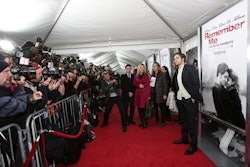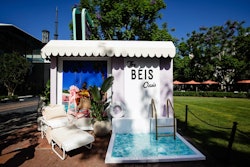
Let's put it out on the table: It's OK to want media coverage for your hard work! While it may not be on every producer, designer, or planner's agenda to see their creative ideas printed in a magazine or garnering page views on a media site, it is for some—and that's A-OK.
If you fall in the latter category, here are some tips from yours truly—the BizBash editors—to help get you published by media outlets that cover events of all types, including BizBash.com.
1. Timing: Your pitch should be relevant right now.
First things first, take note of the "3 Ts of Media," which are timing, topic, and targeting. Start with timing: When pitching a story, there should be a clear answer to "Why now?" Why should readers know about this right now? If pitching an event specifically, do so before or right after it happens to ensure it's timely for reporting. Additionally, a story could be considered "evergreen" content, which is also coveted to media outlets as it remains relevant for a longer period of time.
2. Topic: Ensure the topic or angle fits into the media outlet's existing coverage.
Before you pitch a media outlet, familiarize yourself with the type of content and coverage they provide. Will the topic of your story fit in with their coverage? Do you see reporting on similar stories or events to validate your pitch?
For example, at BizBash, especially since the pandemic, we’ve been shifting from hyperlocal coverage (i.e., content and takeaways that would only benefit planners in one market) in favor of universally relevant advice, resources, and innovative ideas that could be relevant to events and planners across the globe. So while we continue to cover events from all markets, we look to ensure the key takeaways and lessons learned could apply to numerous planners. We focus on ideas and trends in catering, decor, entertainment, production, and technology—all the elements that go into successful events and meetings. We've seen great examples from all over, but we'd love to feature more events from areas we haven't covered as much, from Calgary to Cleveland, Maine to Montana, San Francisco to Atlanta, Austin to Montreal, and everywhere in between.
3. Targeting: Clarify how the story would benefit the site or publication's readership specifically.
If a pitch is timely and has a topic that is relevant to the media outlet's readers, the next few questions to answer are: Would the readers care? How would it benefit them? Are there key takeaways from the story, and are they different from what has already published?
At BizBash, we don’t only try to offer our readers news on what happened, but also more information on why and how it happened. We’re looking for those nitty-gritty details of event production to give a true peek over the fence at how an event came to fruition from start to finish. Additionally, although we don't cover personal/social events like weddings and birthday parties as often, we'd still love to see photos of great ideas from those kinds of events too.
4. Make it easy for the editor to visualize the story and its angle.
Spell out the story, and it’s more likely to get published—including vendor details when applicable, event dates, event location, key takeaways (what can others learn from this). When pitching to a digital media outlet like BizBash, editors are likely working on tight deadlines, often turning around stories in a matter of just a few days. So, the less back and forth there is trying to nail down whether a story fits into their content, the better. Outside of pitching events for coverage, oftentimes editors are looking for subject matter experts to quote for stories, so you can also pitch them for what topics you’re most familiar with and comfortable speaking about.
5. Send images!
While it pains us to say this as writers and editors, people don’t read as much as they used to! Because of that, great imagery really drives a story and keeps readers' attention for longer. Adding on to the previous tip of painting the picture for editors, do that by attaching a few sample images to your pitch email or even sending through a full Dropbox link (don't forget to ensure you have permission to share these images and include a photographer to credit, if applicable). If you're pitching to a print publication, you'll need to have high-resolution images available. A high-resolution image is 300dpi; online images are usually 72dpi.
6. Offer exclusive content or fresh takes on a previously published event.
If you're pitching your event or story to multiple media outlets, especially after it's already been published, offer a different angle that hasn’t been covered yet, and editors are more likely to accept it. At BizBash, for example, even if we overlap coverage with other media outlets, we aim to always provide a different, fresh angle or take on the event to offer our readers another way of looking at it.
7. Keep pitching—but know when it's time to move on to the next media outlet.
Getting the attention of editors isn't always a "one and done" situation, so play the numbers game and keep pitching new ideas—unless the editors tell you otherwise. If they do, it may be that your content is a better fit for a different media outlet, because it doesn't fit the topic they're looking for. Especially if your stories are never getting picked up by the media outlet you're continuously pitching, evaluate whether you're achieving the 3 T's of Media for that outlet. If not, see if another site or publication is a better fit for your story or event.
Also, know that editors tend to keep numerous ideas on file to curate a bigger story. At BizBash, unfortunately, we don't have the time, space, or people power to cover everything, so pitching an event doesn't guarantee we'll write about it immediately. But if we don't write about the event or product on its own, we'll still consider it for future articles on, say, cool catering trays or unusual entertainment acts or interesting entrances. Keep in mind, too, that BizBash produces monthly online features like "Cool Event Ideas of the Month," "Event Tech Check," "What's New in Event Venues," and "What's New in Meetings and Trade Shows," where we can incorporate newsworthy items if they're not a fit for a standalone story.
We strive to feature a lively mix and to balance several factors: We're looking for innovative ideas and strategies that can inspire readers; new and newsworthy events and concepts; and a mix of industries, vendors, brands, and types of events.
8. Be patient!
Editors receive a lot of pitches and emails, so allow them a few days to review your pitch before following up or getting discouraged. It’s likely they're discussing the story internally with their team to determine how the pitch could turn into a full story, who will write it, and when it would be published, among other details.
9. Set your ego aside.
People sometimes assume editors of industry-focused outlets know about every event happening. While we find that flattering, it's not necessarily true. At BizBash, we count on our readers and network of planners to send us information about their most interesting and innovative work. Please do! You can always email us at [email protected]. We love e-meeting new faces and learning about everything you’re doing to move the industry forward. Plus, no one has to you know pitched your own event or nominated yourself for an award—it'll be our little secret (wink, wink).
Bonus Tip: Stay connected!
The best and easiest way to stay updated on what timely topics we're covering at BizBash is to stay connected with us via social media, newsletters, etc. Follow @BizBash on social media platforms, and subscribe to the BizBash Buzz newsletter to stay up to date on when nominations go live for our big profile features, such as "10 Most Innovative Meetings," "BizBash x Connect 15 Over 50," and "Industry Innovators." See dates here. Want even more content to hit your inbox? Sign up for Beyond the Buzz, where you can select the industry topics you're most passionate about.



![Pag 4571[3]](https://img.bizbash.com/files/base/bizbash/bzb/image/2024/06/PAG_4571_3_.665f33fa2b275.png?auto=format%2Ccompress&fit=crop&h=100&q=70&w=100)







![Pag 4571[3]](https://img.bizbash.com/files/base/bizbash/bzb/image/2024/06/PAG_4571_3_.665f33fa2b275.png?auto=format%2Ccompress&fit=crop&h=112&q=70&w=112)







